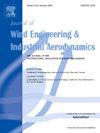Validating spatial reproduction of large-eddy simulations with PIV datasets for turbulence statistics at pedestrian level of urban canopy
IF 4.2
2区 工程技术
Q1 ENGINEERING, CIVIL
Journal of Wind Engineering and Industrial Aerodynamics
Pub Date : 2025-01-31
DOI:10.1016/j.jweia.2025.106018
引用次数: 0
Abstract
For large-eddy simulations (LES) at pedestrian levels of urban canopies, accurate validation with wind-tunnel experiments is essential. While extensive LES research has been conducted, validation often focuses solely on fundamental statistical profiles above the urban canopies, disregarding the dramatic spatial variations and higher-order statistics within the flow field, particularly at pedestrian levels. Therefore, this study systematically validated the spatial distribution of various LES-derived statistics against PIV data within a cubical array, focusing on critical height of (where is the cube length). In addition to fundamental statistics, higher-order statistics were quantitatively validated with a hot-wire anemometer (HWA) above the canopy. Furthermore, to ensure the reliability of the LES results, a sensitivity analysis was conducted to assess the impact of the mesh resolutions and domain sizes. The mesh aligns with PIV results for mean and standard deviation at , offering a balance between accuracy and computational cost. In terms of validation metrics, the mesh indicated the best consistency with the velocity skewness and kurtosis obtained by HWA above the canopy. While the turbulent length scale is affected by domain size when using cyclic boundary conditions, utilizing a of streamwise length reproduces a more reliable streamwise integral length scale with the experiment for and spanwise lengths. However, a sharp reduction in the streamwise integral length scale was observed when using in spanwise length. By incorporating these detailed validations, this study aims to underscore the key roles of both mesh resolution and domain size in accurately verifying and validating LES models for simulating pedestrian-level winds.
基于PIV数据集的城市树冠层湍流统计大涡模拟空间再现验证
对于城市树冠层行人水平的大涡模拟(LES),风洞实验的精确验证至关重要。虽然已经进行了广泛的LES研究,但验证通常只关注城市树冠以上的基本统计概况,而忽略了流场中戏剧性的空间变化和高阶统计,特别是在行人水平。因此,本研究针对PIV数据在立方体阵列内系统验证了各种les衍生统计量的空间分布,重点关注0.1H的临界高度(其中H为立方体长度)。除了基础统计外,还利用热线风速计(HWA)对高阶统计进行了定量验证。此外,为了确保LES结果的可靠性,进行了敏感性分析,以评估网格分辨率和域大小的影响。H/40网格在0.1H时与PIV结果的平均值和标准偏差对齐,在精度和计算成本之间提供平衡。在验证指标方面,H/60网格与HWA在冠层上方获得的速度偏度和峰度的一致性最好。当使用循环边界条件时,湍流长度尺度受区域大小的影响,利用16H的流向长度与4H和8H的展向长度的实验再现了更可靠的流向积分长度尺度。然而,当跨度长度使用2H时,观察到沿流积分长度尺度的急剧减少。通过整合这些详细的验证,本研究旨在强调网格分辨率和区域大小在准确验证和验证用于模拟行人水平风的LES模型中的关键作用。
本文章由计算机程序翻译,如有差异,请以英文原文为准。
求助全文
约1分钟内获得全文
求助全文
来源期刊
CiteScore
8.90
自引率
22.90%
发文量
306
审稿时长
4.4 months
期刊介绍:
The objective of the journal is to provide a means for the publication and interchange of information, on an international basis, on all those aspects of wind engineering that are included in the activities of the International Association for Wind Engineering http://www.iawe.org/. These are: social and economic impact of wind effects; wind characteristics and structure, local wind environments, wind loads and structural response, diffusion, pollutant dispersion and matter transport, wind effects on building heat loss and ventilation, wind effects on transport systems, aerodynamic aspects of wind energy generation, and codification of wind effects.
Papers on these subjects describing full-scale measurements, wind-tunnel simulation studies, computational or theoretical methods are published, as well as papers dealing with the development of techniques and apparatus for wind engineering experiments.

 求助内容:
求助内容: 应助结果提醒方式:
应助结果提醒方式:


